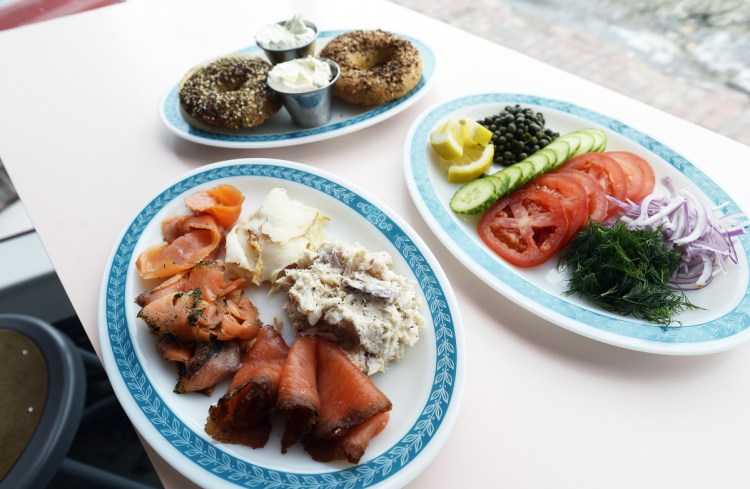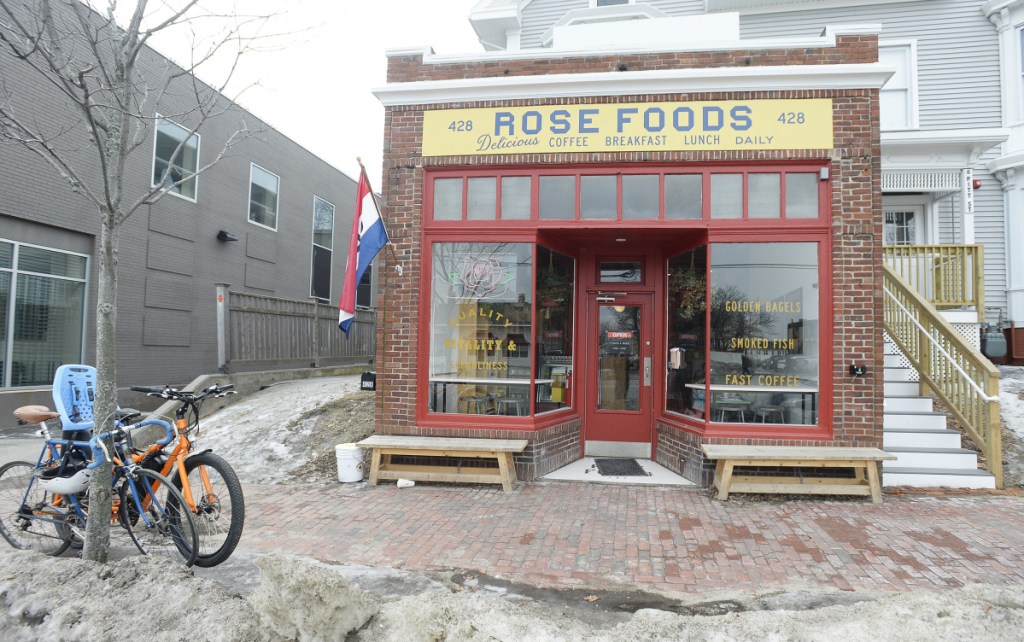There is no such thing as a perfect bagel. Some people prefer compact, sweet Montreal-style bagels, some the doughier New York variety. But even within a single category, quite a bit of variation exists. So much so that New Yorkers themselves can’t (won’t?) agree on a single favorite. A few steps down any sidewalk in Manhattan will take you out of Ess-a-Bagel territory, into H&H’s, or even Murray’s. They’re all made with the same basic recipe, but ask a devotee to eat a less-preferred brand, and you’re likely to hear the most damning of all the bagel put-downs, “It’s fine, but it’s not a bagel.”
I was there to witness my college friend Patric, then a newly arrived Swedish exchange student, taste his first bagel. We were at breakfast one morning, when he looked at me wide-eyed, then down at his plate. He had taken a bite of a plain bagel. “This,” he said, spitting it out, “is a most disgusting doughnut!” So I took him to the toaster and tried to tell him about our country’s version of the quick-boiled, yeasty Jewish classic. But after his initial trauma, he was never truly able to enjoy one. With bagels, it’s all about expectation.
Chad Conley, the owner of Portland’s Rose Foods, will tell you that, when he baked his first bagel, his own expectations were extremely low. For a few years, he had been percolating the idea to open a Jewish deli, inspired by a visit to Toronto, where he discovered Schmaltz Appetizing, an ultra-casual lox-and-cream-cheese deli, around the corner from where he was staying. “I wasn’t even thinking about food on that trip, but I went to their shop, and they didn’t even make their own bagels,” he said. “But it was so awesome, and I went back every morning. I totally fell in love.”
As business at the widely acclaimed Palace Diner in Biddeford settled into a comfortable groove, Conley, a co-owner of that restaurant, decided it was time to get to work on developing the menu for his new endeavor. But first, he needed to know how to make a good bagel. He started by grabbing a baking book and following a recipe verbatim. “It was terrible,” he said of that first batch. For the next several months, he read, researched and made hundreds more bagels, adjusting one element at a time until he started to internalize the techniques and processes.
“I never felt like my job was to create the best bagel in Portland,” Conley explained. “I wanted something texturally and flavor-wise that was missing here: a light exterior crust and a bagel that isn’t dense, a bagel that is designed to be made into a sandwich. People who grew up eating New York bagels will probably say this is not it.”
Indeed, a bagel purist would likely deem his methods unusual, at the very least. Conley uses both sourdough and yeast, as well as a long, cold rising to develop lightness. He also borrows a technique from pretzel making, boiling the proofed circles of dough not in plain water but in a lye solution. The pre-baking bath isn’t quite as alkaline as what you’d use for pretzels, but is just enough to produce a dusky gloss and a distant insinuation of bitterness.
Conley is right: They work beautifully as sandwiches. On the Monday Morning ($8), a sandwich filled with roasted chicken livers roughly chopped together with hard-boiled eggs, full-sour pickles from Guss’s (also available a la carte for $3.25) and lightly caramelized onions, the open structure from the bagel holds all the tiny, crumbly bits of the mixture and sops up all the decadent schmaltz (chicken fat) clinging to the gribenes (crisp, chicken skin cracklings) scattered throughout the mixture.
The bread-like crumb also soaks up the briny sautéed vegetable juices on Rose’s vegetarian sandwich, the Harbor Master ($11). Here, chef Matt Jatczak and his team simmer collards, onion, cider vinegar and dried kelp from Maine Sea Coast Vegetables to inject flavors of the sea into a dish that doesn’t feature fish. Topped with eggs (mostly whites) and a thin layer of smoked cheddar – “to bring smokiness people are missing when they aren’t getting smoked fish,” Conley said – it’s a modern dish, but one that feels like it fits right in to the otherwise very traditional menu.
Rose Food’s space shares that same sensibility: classic elements set off against fresh, contemporary ones. Take the mix-and-match dishware that includes new pieces alongside blue-and-white, 1950s-era Fire King platters. Or laminate tabletops and a haphazard collection of chairs that give the dining room warmth, despite a paucity of natural light from the small, high-set windows.
The interior didn’t always look this good. It was dingy and dark inside when Conley first found the space, once the home of Brea Lu Café (now in Westbrook) until a fire in the adjacent residential section of the building forced them out and prompted the landlord to gut the entire building.
Today, light pinballs deliriously around the front room – bouncing off a partially tiled, white wall anchored by blonde-wood shelving that holds Pyrex casseroles, cookbooks, Dr. Brown’s sodas and U-Bet syrup bottles, until eventually refracting through a vintage yellow gumball machine filled with neon-shaded Mike N’ Ikes candies. It’s hard not to get a little giddy just stepping in the door.
It also helps that the first thing you smell when you walk in the door is latkes. Not the thin, lacy potato pancakes most home cooks prepare, though. Rose’s are chubby, the size of a donut peach, fried to a deep brown and served with applesauce and sour cream ($8), as well as black Bowfin caviar for an extra $8. Either way you choose to order them, they are crisp on the outside, tender on the inside and just plain terrific.
Latkes aren’t light, though. To help, Conley offers a few items designed to offer balance to the restaurant’s heavier dishes, like Rose’s Salad ($4), full of chunks of cucumber, radish and plenty of cottage cheese over-generously seasoned with salt and black pepper. “It’s a weird throwback, my wife’s family recipe. Foodie people would look at those ingredients and wonder what’s going on here,” he said.
A better choice is Rose’s version of a dish so beloved that it finds its way into every spiral-bound Jewish community cookbook published in the past century: Health Salad, a modified marinated cole slaw, here upgraded with shaved fennel bulb, celery root, scallions and dill ($4). The slaw’s acidic, herby tang is a potato pancake’s perfect foil.
Equally, Health Salad is an excellent complement to the Fisherman’s Feast ($32, for two), a miniature feast that could easily feed three. You start by choosing two types of bagel. Of the five flavors I have tasted over several visits, I believe baker Kevin Gravito’s best are his sweet, malty pumpernickel and savory pastrami spice. I’m generally stubbornly doctrinaire about wacky bagel flavors – I’d rather have minor surgery than eat a blueberry-bacon or rainbow funfetti bagel – but pastrami spice, with garlic, mustard seed and paprika, seems like it could be a long-lost classic.
Along with the bagels, two flavors of cream cheese (always opt for the slow-burning horseradish), tomatoes and onions, arrive sizable portions of smoked sable, Nova lox and pastrami Nova, all sourced from Samaki Smoked Fish in Port Jervis, New York, as well as Ducktrap gravlax. To an item, the bagel toppings are fantastic. On one visit, I stopped at the retail counter and bought some of the house-flaked whitefish from ACME Smoked Fish in Greenpoint, Brooklyn, on my way out the door.
But why, with such strong in-house talent, isn’t Rose Foods curing its own fish? I asked Conley. “It’s a flaw I see a lot in restaurants. If I make pickles, it might be fine, but suddenly I have a little less time each week. I believe in doing the things you can do really well and accepting when people are doing other things better, and then supporting them in buying their products. There’s no shame in that,” he said. “One of the lessons I’ve learned as a restaurateur and chef is that it’s important to recognize your limits and to know when you overextend yourself. It has consequences that can lead to a worse customer experience – people don’t get what they expect.”
Andrew Ross has written about food in the United Kingdom and in New York, where he co-founded NYCnosh, a food website. He and his work have been featured on Martha Stewart Living Radio and in The New York Times. He is an internet researcher and higher education consultant. Contact him at:
andrewross.maine@gmail.com
Twitter: @AndrewRossME
Send questions/comments to the editors.



